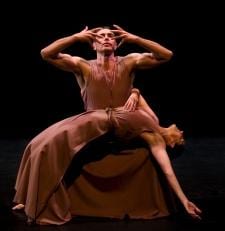Living Dances, a stunning evening of dance showcasing contemporary works by choreographer James Kudelka, was marred by a badly conceived and executed new work.
The world premiere of Kudelka’s slight and under-realized Beautiful Movie by Coleman Lemieux & Compagnie (CLC) was a confounding experience. The short piece opened with countertenor Daniel Taylor accompanied by musicians from his Theatre of Early Music performing “Erbarm Dich Mein” by Heinrich Schütz. The musicians and the company dancers were arranged in a loose semicircle observing Taylor walk barefoot in a circle around a toy chair with a doll on it. The music switched to the “Erbarm Dich” aria from JS Bach’s St Matthew Passion. Bill Coleman slowly moved in to animate the doll: Taylor and the doll regarded each other, the doll pulled itself up along Taylor’s arm to hug his neck, Taylor seemed alternately entranced and annoyed, often holding the doll by the ankles and carelessly letting it dangle.
Dance is a strange thing, so abstract. We read into a performer’s body so much of our own emotion and story. And a doll or puppet can be a perfect vehicle or empty vessel into which we pour incredible feeling — not this doll and Coleman’s haphazard animation of it. Ugh. Add some black light and we’d be in Famous People Player territory.
The piece wasn’t helped by the musicians’ lackadaisical playing, especially first violinist Adrian Butterfield during the Bach aria. This is some of the most sublime music in the western cannon. You have to work hard to make it boring. Taylor’s singing, while lovely-sounding, lacked drama.
“Erbarm dich” (have pity), sings a solo voice to a weeping violin after Peter has denied Christ and is filled with remorse and self-hatred. I felt nothing but dismay.
The whole thing was like a bitter palette cleanser for the sumptuous feast to follow: three amazing works by Kudelka.
See #1 (from 2007) was a solo piece danced by Laurence Lemieux set to the Passacaglia Sonata by Heinrich von Biber as played by Butterfield. Lemieux constantly returned to the front of the stage to gaze out to the horizon, or perhaps look at herself in a mirror or into her future, an arm crooked like a cat’s paw or a hand stroking the back of her neck. She’d run around the stage with upturned hands, arms half extended, reminiscent of Ukrainian peasant dances, alternately kicking her heals together or crumpling to her knees sideways. She’d get back up only to run ever more frantically or stare off searchingly. The whole mood was sad, expectant. A spare, very moving piece.
Sudain, l’Hiver Dernier (from 1987) was a punch to the stomach. Two male dancers, Andrew Giday and Michael Sean Marye, standing shoulder to shoulder, seemed to swim in place with whirling interlocking arms that built into a series of complicated, highly athletic lifts — wrapping around each other, turning each other upside down and holding the other perpendicular, or spinning up to the shoulders of one to lie prone or curled up. Both dancers kept retreating to that curled up, fetal position; the other would then hold himself overtop or try to rouse his partner. Everything was about mutual support and need, a tender relationship under siege.
It sounds too literal to describe one man being a shelter to the other or how one supported himself by leaning heavily on the other’s thigh like a lean-to. Certainly with its soundtrack of “Jesus Blood Never Failed Me Yet” by Gavin Bryars that literal interpretation is valid. In 1971 Bryars looped a recording of a street person singing as the basis of the composition.
If you didn’t know the origin of the music, then the piece read as something more abstract. I felt the piece showed how men seek protection in the architecture of each other. The dark-hued ’30s styling of these two pieces by Jim Searle and Chris Tyrell of Hoax Couture also brought to mind the Depression and the Dust Bowl.
Giday and Marye are two beautiful men and I’m the first person to sexualize dance… but this piece was astonishing for how passionate it was without being sexual. They never looked at each other in the eyes. Perhaps it’s as if they couldn’t acknowledge any deeper intimacy.
It’s one of the most powerful male pas de deux I’ve ever seen.
The final piece on the program was In Paradisum with music by Michael Baker. Originally created for Les Grandes Ballets Canadiens in 1983 this short ballet was reset by Kudelka for a smaller ensemble of nine led by Marye, Lemieux and Giday.
The dancers, male and female, were dressed in long full skirts and simple tunics that immediately created a sacred setting — whether ancient Greece, a medieval monastery or whirling dervishes.
And whirl they do bursting with righteous ecstasy in full Martha Graham-mode, with hands like blades, arms outstretched, while Lemieux and Marye begin to dance together. Marye towers over the other dancers — it’s as if Lemieux is approaching her maker. The corps’ movements, with every dancer getting to strut his or her stuff, always seemed to be fighting gravity, stretching the body to its physical limits.
Despite a few tender tearful moments between Lemieux and one of the women, this was a joyful death, full of energy, renewal and hope.
The second section was a solo for Lemieux; the rest of the dancers slept, their bodies forming a circle around her. Death is a solitary journey and yet, as she moved, she pulled the circle of sleeping bodies with her. Ghosts, memories, earthly ties, it’s a haunting, enigmatic image.
Marye stumbled during a pas de deux with Lemieux, recovering quickly. It was an important reminder of how every element of a Kudelka dance is incredibly difficult, in this case the interlocking footwork. I could watch this piece over and over and never tire of it.
Kudelka suddenly left the National of Ballet of Canada in 2005 where he was artistic director for nine years. He has had a fruitful relationship with CLC since 2006 and is now choreographer in residence. The company performed his three earlier works beautifully. Which makes the failure of the opening piece so distressing. I hope Kudelka the choreographer has only stumbled… to make me appreciate his difficult genius that much more.


 Why you can trust Xtra
Why you can trust Xtra


